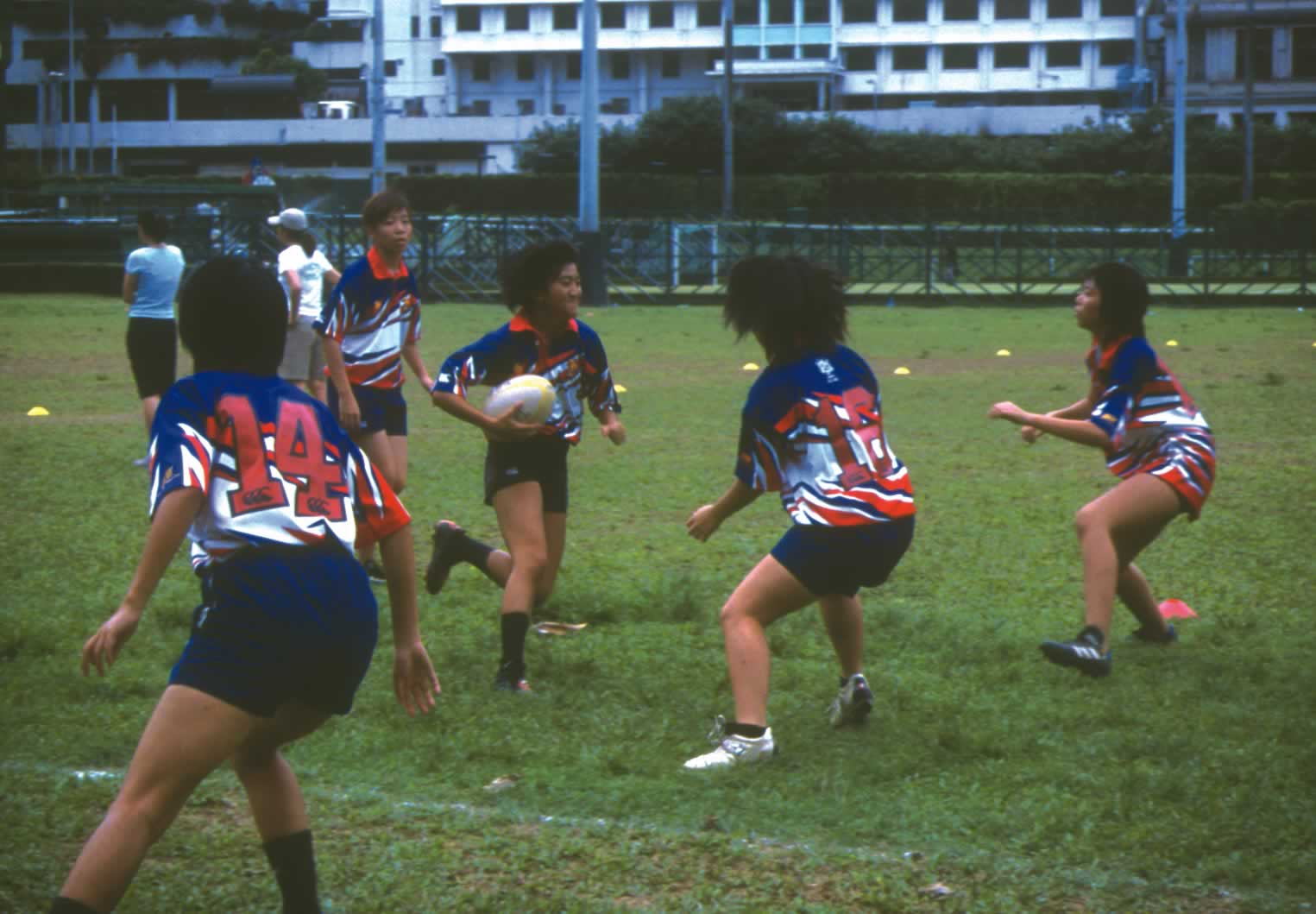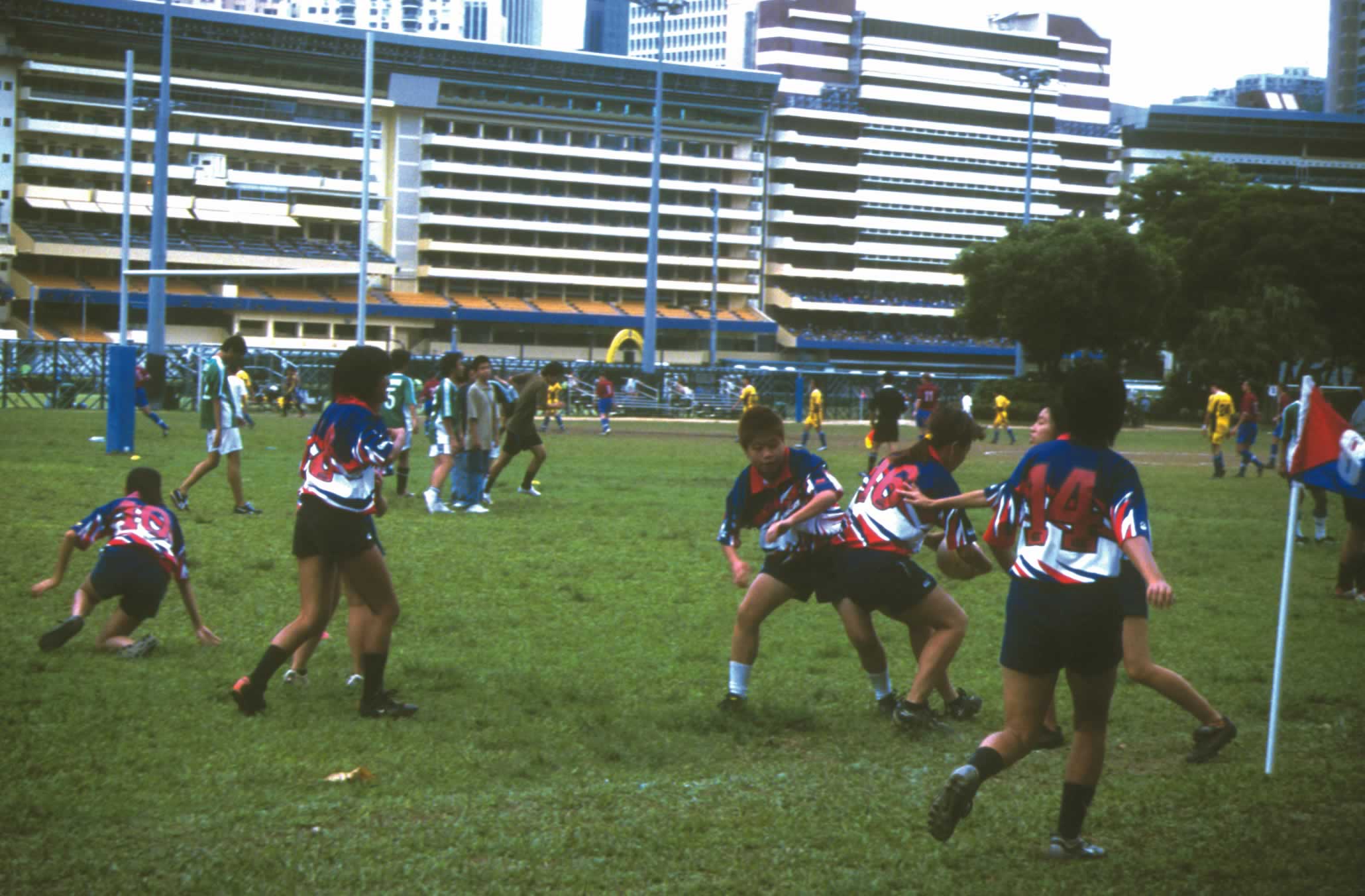Not for men only
Rugby girlsBy Candy Tong
Female rugby players.
Rugby, a sport demanding physical strength and stamina, has been traditionally played by men. Recently, women have also started playing this game in Hong Kong.
According to Cheung Wing Hung, chief coach of the Tai Po Dragon Rugby Football Club, a female team, the game has a long history.
Mr. Cheung said a group of children played football in Britain about 100 years ago. Tired of just kicking the ball, they started playing with their hands. Since the city they lived in was called Rugby, this sport was named after it.
Mr. Cheung said, “Before 1997, rugby was a game for foreigners in Hong Kong. However, after 1997, Hong Kong is no longer a British colony. Nowadays, there are more Chinese coaches. More local people are playing rugby.”
A group called the Touch and Tag Association has been organizing rugby activities and competitions recently. It aims at promoting rugby and attracting new players. Normally, there are 15 players on a team. However, for mini-rugby, there are only six or seven players.
“Most people think that athletes playing this game have to be strong, but it is not necessary. Instead, they have to be nimble. More importantly, they should be healthy, both physically and mentally,” said Mr. Cheung.
He said that rugby is a highly cooperative sport. It requires unity, which is important for a team.
Rugby has become more and more popular among women in Hong Kong.
Janet Pang, 19, is the captain of the Tai Po Dragon Rugby Football Club. “After taking the Hong Kong Advanced Level Examination, one of my friends invited me to play rugby with her,” she said. “I had seen some rugby games on TV, and I thought that it would be quite interesting. Moreover, I like sports. I wanted to try different ball games, so I started playing rugby.”
She used to think that people playing rugby had to be tough. However, after joining the team, she discovered that strength was not essential.
“Whenever people realize that I am a rugby player, they usually find it strange, because most people regard it as a masculine sport. Nevertheless, it is not true,” she said.
She also said playing rugby is not particularly tiring, compared to other ball games. It is similar to playing basketball.
According to Mr. Cheung, women are weaker than men physically. A woman’s basic body structure is different from that of a man. Some parts of women’s bodies, like their breasts and stomachs are weak and easily get hurt. They cannot collide with one another. Therefore, colliding is avoided in practice.
Besides, he said, women are less creative than men. Women seldom create new ideas to play rugby. They are more dependent on the coach. On the other hand, men play the game in many creative ways.
On the other hand, women are stronger than men in three respects.
Firstly, women have better memories than men. They can follow exactly what the coach asks them to do, but men cannot. Men are less obedient and more forgetful.
Secondly, women tolerate pain better than men, although men seem to be stronger and more energetic.
Thirdly, women recover their energy faster than men. This characteristic is inborn. As a result, women can practise more frequently than men.
According to Tam Kin Fan, a former male member of The Chinese University of Hong Kong Rugby Football Club, a mixed rugby team, women players are not inferior to men.
“I used to think that it would be hard for women to play rugby. However, after playing with them several times, I have realized that they do not have many disadvantages in playing rugby. They can do what men do.”
He said it is not necessary for female players to be physically tough. They have to run fast. Also, they should be able to grip the ball tightly when it is passed to them.
He said, “When playing with women, we should be careful. We have to avoid touching or colliding with them in order to prevent any embarrassment. Mixed rugby teams prefer tag rugby, because players just have to pull others’ tags off. It requires minimum body contact.”
He joined a men’s rugby team, too. He said playing on a mixed team is fun. More importantly, players often have greater sense of belonging to a mixed team.
A worldwide rugby tournament, Rugby Sevens, is held in Hong Kong every spring. It attracts international rugby players from different countries, such as Australia and Singapore, to take part in it. Next year, it will be held in the Hong Kong Stadium from 28 March to 30 March.
Mr. Cheung predicted that rugby will become more popular. Most rugby players are physical education teachers and tertiary students, and he thinks that they would probably continue playing it, making rugby part of their lives.
Players gather before a game. .
Rugby football, tag rugby and touch rugby
By Candy Tong
Left: Olive-shaped ball used in rugby. Photo by Candy Tong
There are three types of rugby: rugby football, tag rugby and touch rugby.
The equipment needed is an olive-shaped ball. For Rugby football, there should be two H-shaped goals, too.
Rugby football is the toughest of all. The players often collide with each other and try to knock others down. They have to pass the ball to teammates when they are knocked down.
Tag rugby and touch rugby are more popular in Hong Kong. Their rules are similar.
Players start the rugby match at the center of the pitch by softly kicking the ball forward.
For tag rugby, each player has to wear a belt that has two Velcro tags attached to it. The defenders have to pull one of the Velcro tags from the ball-carrier. Then the game has to be restarted by passing the ball backwards to other teammates.
For touch rugby, the defenders have to touch the attackers, on any part of their bodies. Then, the game starts over. The players should pass the ball backwards by rolling it between their legs.
Meanwhile, the defending team has to move five meters backwards.
If a team has six “touches” or “tags”, there is a “change over”. The attacking team has to pass the right of holding the ball to the opposing team.
For both games, there is a “try line” at each of the two ends of the rugby pitch. Whenever both feet of the players pass the “try line”, they score one mark.
For Rugby football, passing the “try line” scores five marks. In addition, there are two more ways of scoring, including a “penalty kick” and a “conversion”. In both cases, the players score marks by kicking the ball through the two posts of the H-shaped goal.


